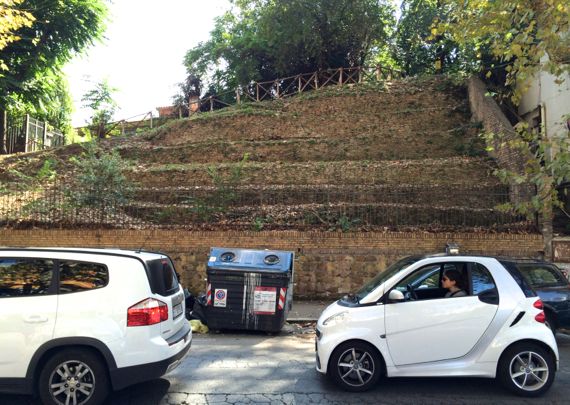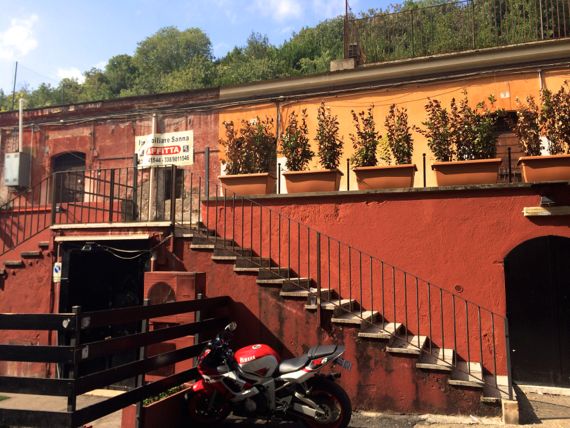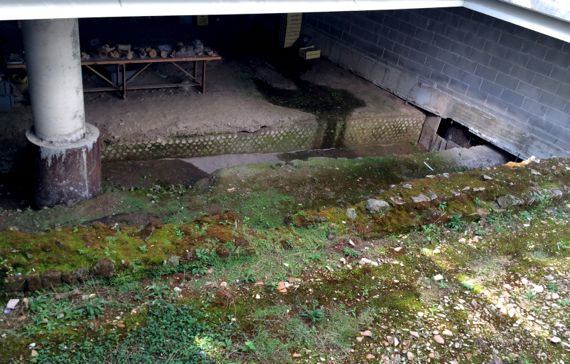
Google Earth satellite view of Monte Testaccio. From left to right, the arrows point to: ruins preserved in modern market; stacked sherd terraces near closed entrance to the summit; clubs along the west side; and, the stylized amphora fountain.
About 2km southwest of Rome’s historic Forum square is Monte Testaccio, alternatively Monte dei Cocci. It is a mountain of potsherds—at least in near-floodplain, it’s a mountain; elsewhere it would be a respectable hill. The variant names come from testae meaning fragment (and thus sherd in the case of pottery) in Latin vs cocci meaning potsherd in Italian.
And that is what it is: a giant pile of broken thick-walled potsherds. It has a circumference of nearly a kilometer (0.6 mi) and stands 35m (115 ft) high (usually reported as 50m). It has the remains of an estimated 53 million amphorae.

Amphorae are, first and foremost, storage and shipping containers. The name is from the Greek and refers to the two handles. Roman amphorae bodies were wheel-thrown and partly dried, then the base, neck, rim, and handles added using coiled clay. Containers with the same basic shape and purpose were made without handles across Eurasia. Amphorae are known from the Levantine coast dating to 3500 BC (the Neolithic). During the succeeding Bronze and Iron Ages, amphorae use spread around the Mediterranean. The form of amphorae are optimized for safely containing liquids.
Parts of Monte Testaccio were deliberately engineered with retaining walls made of amphorae filled with fragments, and interior fill of amphorae fragments that had been dusted with lime undoubtedly added to reduce odor. Excavations have revealed slips and collapses indicating the pile wasn’t always stable. Researchers have also discovered dumping platforms, which would have made pile-creation more efficient.
Archaeologists have mapped the zones of deposit identified by age of the sherds (generalized)—dates can be ascertained to the exact year, in many cases (so very rare in archaeology!). The oldest sherds that have been found date to ~30 BC. They are from the northern side of the pile, closest to the city’s original port area. As the city spread out, the dock/port area was moved downstream a bit, to adjacent to the Monte Testaccio location. Excavation data indicate that workmen first created a tall mountain, then spread it to the west (toward the river) in stepped vertical layers (platforms). The pile undoubtedly was higher than it is today in its last years of active use.
Most of the amphorae can be identified by stamps put on each vessel while the clay was still damp; they came from only a few places. By far the most common type of amphorae came from the Roman province of Hispania Baetica, from production areas in a small zone mostly along the central Guadalquivir River. Mireille Corbier (2005:418) says farmers transported the oil in skins on mule-back to the Baetica collection area, where it was transferred into the amphorae. Then, it was “taken by boat down the river as far as Seville, and finally loaded onto sea-going vessels to continue its journey from Seville. All of these operations are carried out in the spring, the season when the rivers are high and the sea ‘open’ to traffic.”

They’ve cleaned up the presentation of sherd-layers on the northeast “corner,” by the locked gate to the steps to the top. Once a catholic pilgrimage site with stations of the cross set up, the top of Potsherd Mountain is now usually closed. I think these are artful stacks of sherds comprising these careful terraces, and not how the interior of the mountain actually looks.

At some point, enterprising residents dug wine cellars and other storage spaces into the sides of the mountain. Many on the east side are now clubs, and quiet when we passed by at mid-day.

North of the current mountain is a new market that replaces the nearby market area that survived for on the order of a century. In the center of the new market, architects left a hole in the roof and the floor that allows views of the sherd-strew horizon that is below the market. This indicates to me that the sherd dump was larger than just the mountain we see today.
This giant sherd-dump indicates just how much olive oil and wine came into the city, for hundreds of years. A lot of effort went into making the amphorae and their contents and moving them to Rome. The contents were transferred to smaller, lighter containers (I assume), then transported into the city, leaving dockworkers and warehouse managers with TONS of amphorae that, poof!, they had no use for.
Corbier, Mireille, 2005. Coinage, Society and Economy. In The Crisis of Empire, A.D. 193–337, edited by Alan K. Bowman, Peter Garnsey, and Averil Cameron, pp. 393–439. The Cambridge Ancient History, vol. 12. 2nd ed. Cambridge University Press, Cambridge.
7 October 2014 at 7:31 am
Pooh says:
I like the recycling container, (I assume), in front of the terraces.